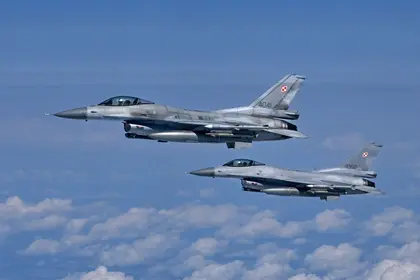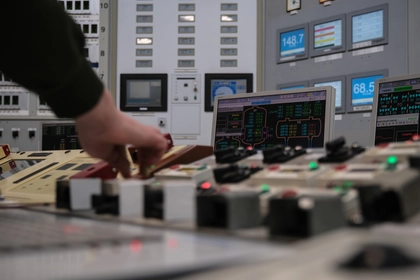What we know:
On Aug. 26 an elite United States Air Force (USAF) unit specializing in wartime jamming, radar detection and related software development announced that its technicians had just upgraded “electronic warfare capacities” aboard F-16 fighter jets donated to Ukraine by Denmark and the Netherlands.
JOIN US ON TELEGRAM
Follow our coverage of the war on the @Kyivpost_official.
Programmers and other technicians from an Elgin Air Force Base unit called 68th Electronic Warfare Squadron (EWS) had “optimized” software in the jets to handle “evolving Russian threats in the spectrum,” the statement said.
The 68th EWS technicians and engineers, working with Dutch and Norwegian counterparts updated programming in “an unfamiliar EW system” installed in the F-16s, and in two weeks had installed “a best-ever mission data file” in the Ukrainian jets’ computers, the statement said.
The 68th, according to the press release, is the US Air Force’s lead organization for developing and updating electronics warfare software for F-16s operated worldwide. The Ukrainian Air Force is now the 31st to fly F-16s and will, like other states using the jet, receive regular software updates, the press release said.
What can we say pretty much for sure:
It is almost certain that the “unfamiliar EW system” the 68th EWS technicians were working on and installed updated software into is a Danish electronic warfare system called an ALQ-213(V).

IMF Approves $1.1 Billion Loan Disbursement to Ukraine Before Trump Inauguration
In simple terms, the ALQ-213(V) is a computer system designed by the Copenhagen-headquartered company Terma to tie all the sensors and self-defense systems in a military aircraft into a single black box controlled by the pilot.
The Danish Air Force installed the ALQ-213(V) system into its F-16s during the 2000s as part of an announced national military enhancement contract. Ukraine’s government has said the first F-16s its Air Force has put into combat were donated by Denmark. Therefore, it is not confirmed, but nonetheless extremely likely that the F-16s the Ukrainian pilots are now flying, have that system aboard.
What’s probable:
Commonly, software for military electronics warfare systems contain data like wavelengths of enemy radars, flight characteristics and radar signatures of enemy missiles, and – sometimes – specific data on how the airplane’s own defense systems might fake its location or how it looks on an enemy radar screen.
The mission of the 68th EWS, among other tasks, is to take data collected on potential threats to F-16s, worldwide, and develop software to help pilots overcome the threats. This could be, for example, the latest radar profile of a Russian Su-35 fighter jet showing up accurately on an F-16 video screen, or algorithms telling an F-16s defensive measures dispensers when to drop flares or chaff, depending on the known speed and flight characteristics of specific Russian surface-to-air missile.
Although the upgrade’s contents are highly secret, and assuming the press release was telling the truth, it is reasonable to expect that whatever threat profiles and electronic warfare data the USAF considers necessary to be in an F-16 electronics warfare computer for the pilot to defend himself, are now aboard the Ukrainian F-16s.
It is also highly probable that data is detailed. Near-constant flights by NATO electronics warfare spy planes and spy drones over the Black Sea, adjacent to Russian-controlled air space, have taken place practically daily since Russia invaded Ukraine in February 2022. Their mission has been to collect exactly the kind of electronic warfare data needed by the 68th EWS programmers to write effective algorithms and, critically, ensure that the data profile has been refined and updated over more than two years of air war conducted by the Russian Air Force.
Intense observation of the electronics and radar side of how Kremlin airmen fight, over years, has probably compromised most pre-war Kremlin air war secrets to NATO and the USAF. It is probable the US and its allies have recorded and know down to the millimeter the frequencies and/or flight profiles for every modern air-to-air missile, air defense system, and aircraft operated by the Russian military.
It is more speculative, but still conceivable, that Ukrainian pilots are now, thanks to the US software upgrade, flying F-16s electronically tweaked to find and target Russia’s latest Su-57 “stealth” fighter jet, or dodge Russia’s top-of-the-line S-400 surface-to-air missile.
What conclusions probably would be a mistake:
No matter what data is now inside the computers aboard the F-16s, no matter how detailed and well programmed, it cannot by itself be battle-winning. A rough analogy might be an advanced, multi-function radar detector alongside a primitive radar detector, in the hands of a motorist bent on speeding.
If he employs the better detector chances of avoiding a speeding ticket and spotting a cop first will go up, but it will never be a guarantee, because the battle between driver and traffic police officer will also depend on relative skill, tactics, relative locations, other vehicles, and luck.
The Russian Air Force and its pilots – aside from the first months of the war – have shown intense interest and real respect of Ukrainian air defenses. As Kyiv has slowly fielded more and better air defense systems over the years, the Kremlin’s airmen have evolved tactics and at times systematically exploited Ukrainian weaknesses. Russia’s development and fielding of thousands of glider bombs launched from near impunity outside the range of all Ukrainian air defense systems is only the most recent example of Russian air war skill and competence.
Even if the data inside the Ukrainian F-16s’ electronics warfare computers is now exactly the same as in a NATO F-16, the fact remains that the Russian Air Force has been preparing to fight that exact opponent, for decades.
Another factor arguing for expectation management is that, by the scale of the Russo-Ukrainian War, the reported six F-16 fighters now operated by Ukraine, which, according to a Thursday Wall Street Journal report has just been reduced by one as the result of a pilot-error crash, are too few in number, and their pilots still too unpracticed, to have any effect at all on air battles.
Over time as more pilots and aircraft become available, possibly, Ukraine’s F-16 fleet might become a deadly opponent for a Russian Air Force that is continually taking losses that are difficult to replace. But given the pace of Western training of Ukrainian F-16 pilots, that will take at least two years and probably twice that.
How much will this software update help Ukrainian pilots:
On the other hand, the long-awaited arrival of Ukrainian F-16s to the air battlefield made already difficult mission planning even more complicated for the Russian Air Force, which is now faced with a new set of unknowns.
It was easy enough, for instance, for Russian fighter pilots flying to war in 2022-24 to plan with the assumption that their radars and their air-to-air missiles, developed in the 2000s mostly, would absolutely outrange and out-perform legacy Soviet-era MiG-29 and Su-27 fighters operated by the Ukrainians.
But until the dogfights actually take place, no one can know for sure whether a modern Russian Su-35 fighter and its radars will detect a Ukrainian F-16 with a Terma electronics warfare aboard, or the other way around.
The same question is open when it comes to air-to-air missiles. On paper, the longest-range Russian missile, called an R-37, should be able to shoot at a Ukrainian F-16 dozens of kilometers before the US-made AIM-120 missile could reach a Russian Su-35. But what if the Terma computer knows the frequencies the R-37 missile’s radars use, so that the Ukrainian fighter pilot can punch flares or just present a flight profile making it impossible for his Russian opponent to shoot first?
Engaging a Ukrainian F-16, or even approaching air space possibly containing a Ukrainian F-16, is a new risk for Russian pilots and mission planners. Anywhere the Russian Air Force thinks a Ukrainian F-16 might be present, Russian air operations will almost certainly be more careful and less aggressive.
You can also highlight the text and press Ctrl + Enter






